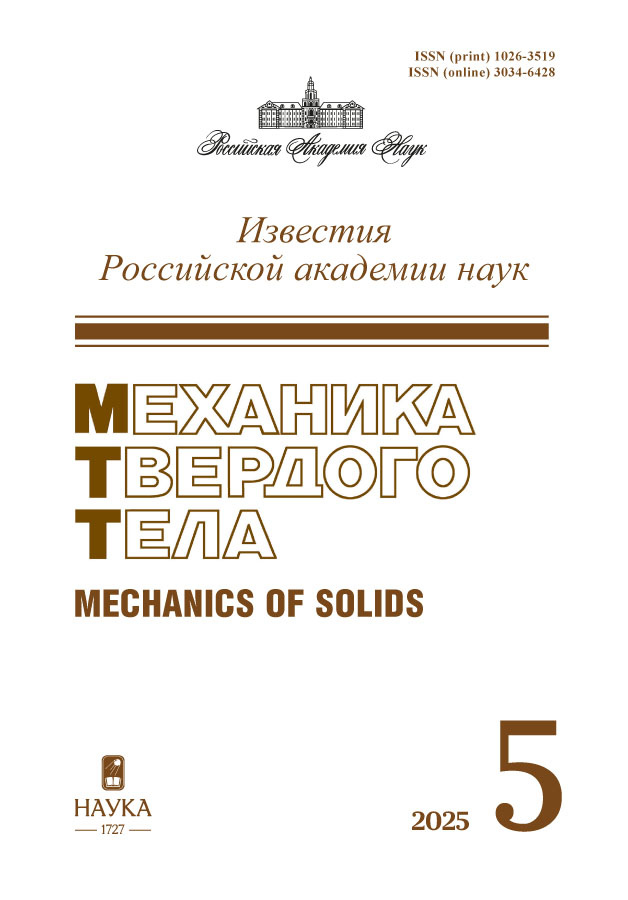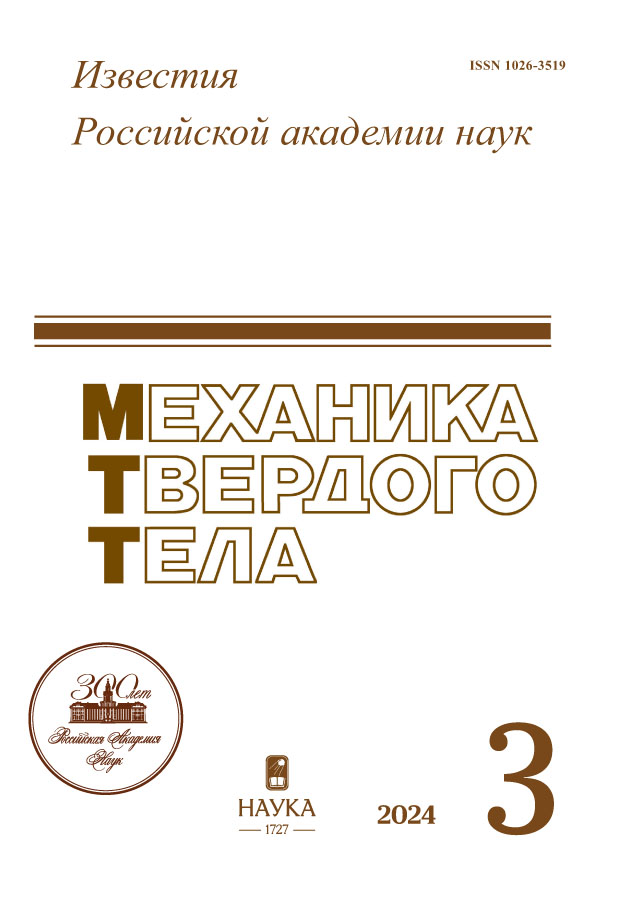Отрицательная ползучесть монокристаллов никелевых жаропрочных сплавов
- Авторы: Епишин А.И.1, Лисовенко Д.С.1
-
Учреждения:
- Институт структурной макрокинетики и проблем материаловедения им. А.Г. Мержанова РАН
- Выпуск: № 3 (2024)
- Страницы: 199–216
- Раздел: Статьи
- URL: https://transsyst.ru/1026-3519/article/view/673072
- DOI: https://doi.org/10.31857/S1026351924030131
- EDN: https://elibrary.ru/uguazo
- ID: 673072
Цитировать
Полный текст
Аннотация
Исследована отрицательная ползучесть монокристаллов никелевых жаропрочных сплавов SRR99 и CMSX-4. Данное явление наблюдали для обоих сплавов при температурах 980–1000 °C и низких либо нулевых напряжениях нагрузки. Предположено, что основной причиной отрицательной ползучести является образование ближнего порядка атомов в сильно легированной кристаллической решетке матричной g-фазы. Дополнительными факторами, влияющими на величину и анизотропию деформации отрицательной ползучести, могут быть релаксация остаточных напряжений: на микроскопическом уровне – мисфитных напряжений между g-матрицей и упрочняющими ее g′-выделениями и на мезоскопическом уровне – дендритных напряжений между осями дендритов и межосными пространствами.
Полный текст
Об авторах
А. И. Епишин
Институт структурной макрокинетики и проблем материаловедения им. А.Г. Мержанова РАН
Автор, ответственный за переписку.
Email: a.epishin2021@gmail.com
Россия, Черноголовка
Д. С. Лисовенко
Институт структурной макрокинетики и проблем материаловедения им. А.Г. Мержанова РАН
Email: a.epishin2021@gmail.com
Россия, Черноголовка
Список литературы
- Evans K., Nkansah M., Hutchinson I., Rogers S.C. Molecular network design // Nature. 1991. V. 353. P. 124. https://doi.org/10.1038/353124a0
- Lim T.-C. Auxetic materials and structures. Singapore: Springer, 2015. http://doi.org/10.1007/978-981-287-275-3
- Ren X., Das R., Tran P., et al. Auxetic metamaterials and structures: A review // Smart Mater. Struct. 2018. V. 27. № 2.P. 023001. https://doi.org/10.1088/1361-665X/aaa61c
- Kelkar P.U., Kim H.S., Cho K.-H. et. al. Cellular auxetic structures for mechanical metamaterials: A review // Sensors. 2020. V. 20. № 11. P. 3132. https://doi.org/10.3390/s20113132
- Городцов В.А. Лисовенко Д.С. Ауксетики среди материалов с кубической анизотропией // Известия РАН. МТТ. 2020. № 4. С. 7–24. https://doi.org/10.31857/S0572329920040054
- Епишин А.И., Лисовенко Д.С. Влияние кристаллической структуры и типа межатомной связи на упругие свойства одноатомных и двухатомных кубических кристаллов // Известия РАН. МТТ. 2022. № 6. С. 79–96. http://doi.org/10.31857/S0572329922060058
- Иванова С.Ю., Осипенко К.Ю., Демин А.И., Баничук Н.В., Лисовенко Д.С. Изучение свойств метаматериалов с отрицательным коэффициентом Пуассона при пробивании жестким ударником // Известия РАН. МТТ. 2023. № 5. С. 120–130. https://doi.org/10.31857/S0572329923600366
- Светлов И.Л., Епишин А.И., Кривко А.И. и др. Анизотропия коэффициента Пуассона монокристаллов никелевого сплава // ДАН СССР. 1988. Т. 302. № 6. С. 1372–1375.
- Baughman R.H., Stafström S., Cui C., Dantas S.O. Materials with negative compressibilities in one or more dimensions // Science. 1998. V. 279. P. 1522–1524. https://doi.org/10.1126/science.279.5356.1522
- Liu Z.-K., Wang Y., Shang S.-L. Origin of negative thermal expansion phenomenon in solids // Scripta Mater. 2011. V. 65. № 8. P. 664–667. https://doi.org/10.1016/j.scriptamat.2011.07.001
- Wittenberg L.J., DeWitt R. Volume contraction during melting; Emphasis on lanthanide and actinide metals // J. Chem. Phys. 1972. V. 56. P. 4526–4533. https://doi.org/10.1063/1.1677899
- Rittich M. The volume change during solidification. NASA Technical Memorandum TM-77817, 1982. https://ntrs.nasa.gov/api/citations/19850015932/downloads/19850015932.pdf
- Lakes R.S. Extreme damping in composite materials with a negative stiffness phase // Phys. Rev. Lett. 2001. V. 86. № 13. P. 2897–2900. https://doi.org/10.1103/PhysRevLett.86.2897
- Fountain R.W., Korchynsky M. The phenomenon of “negative creep” in alloys // Trans. ASM 51. 1959. P. 108–122. https://doi.org/10.1021/ie50595a915
- Timmins R., Greenwood G.W., Dyson D.F. Negative creep in a nickel-base superalloy // Scr. Metall. 1986. V.20. P. 67–70. https://doi.org/10.1016/0036-9748(86)90214-0
- Louchet F. A model of negative creep in nickel-based superalloys // Scripta Metall. Mater. 1995. V. 33. № 6. P. 913–918. https://doi.org/10.1016/0956-716X(95)00299-B
- Branch G., Draper J.H.M., Hodger J.B.M.N.W. In: International conference on creep and fatigue in Elevated Temperature Applications, Philadelphia. 1973. P. 192.1–192.9.
- Mayer K.H., Koenig H. In: VGB-Konferenz “Forschung in der Kraftwerkstechnik”. Essen, 1988. P. 1–24.
- Marucco A., Nath B. Effects of ordering on the properties of Ni-Cr alloys // J. Mater. Sci. 1988. V. 23. P. 2107–2114. https://doi.org/10.1007/BF01115776
- Reppich B. Negatives Kriechen // Z. Metallkd. 1984. V. 75. P. 193–202. https://doi.org/10.1515/ijmr-1984-750302
- Reppich B. Negatives Kriechen und Mikrogefüge langzeitexponierter Gasturbinenwerk stofle // Z. Metallkd. 1994. V. 85. P. 28–38. https://doi.org/10.1515/ijmr-1994-850105
- Kinzel S., Gabel J., Völkl R., Glatzel U. Reasons for volume contraction after long-term annealing of waspaloy // Adv. Eng. Mater. 2015. V. 17. P. 1106–1112. https://doi.org/10.1002/adem.201500159
- Firlus K., Völkl R., Gabel J., Glatzel U. The influence of Cr, Al, Co, Fe and C on negative creep of Waspaloy // Inter. J. Mater. Research. 2021. V. 112. № 2. P. 90–97. https://doi.org/10.1515/ijmr-2020-7980
- Ford D.A., Arthey R.P. Development of single crystal alloys for specific engine applications. Superalloys 1984, Warrendale, Pa.: Metallurgical Society of AIME. 1984. P. 115–124. https://www.tms.org/superalloys/10.7449/1984/Superalloys_1984_115_124.pdf
- Harris K., Erickson G.L., Sikkenga S.L., Brentall W.D., Aurrecoechea J.M., Kubarych K.G. Development of the rhenium-containing superalloys CMSX-4 & CM 186 LC for single-crystal blade and directionally solidified vane applications in advanced turbine engines // JMEP. 1993. V. 2. № 1. P. 481–487. https://doi.org/10.1007/BF02661730
- Lander J.J., Kern HE., Beach A.L. Solubility and diffusion coefficient of carbon in nickel: Reaction rates of nickel‐carbon alloys with barium oxide // J. Appl. Phys. 1952. V. 23. P. 1305–1309. https://doi.org/10.1063/1.1702064
- Link T., Epishin A., Brückner U., Portella P. Increase of misfit during creep of superalloys and its correlation with deformation // Acta Mater. 2000. V. 48. № 8. P. 1981–1994. https://doi.org/10.1016/S1359-6454(99)00456-5.
- Nash P. The Cr−Ni (Chromium-Nickel) system // Bulletin of Alloy Phase Diagrams. 1986. V. 7. P. 466–476. https://doi.org/10.1007/BF02867812
- Okamoto H. Ni-W (Nickel-Tungsten) // JPE. 1991. V. 12. № 6. P. 706. https://doi.org/10.1007/BF02645185
- Cury R., Joubert J.-M., Tusseau-Nenez S., Leroy E., Allavena-Valette A. On the existence and the crystal structure of Ni4W, NiW and NiW2 compounds // Intermetallics. 2009. V. 17. № 3. P. 174–178. https://doi.org/10.1016/j.intermet.2008.11.001
- Schmidt R., Feller-Kniepmeier M. Effect of heat treatments on phase chemistry of the nickel-base superalloy SRR 99 // Metall. Trans. A. 1992. V. 23. P. 745–757. https://doi.org/10.1007/BF02675552
- Hemmersmeier U., Feller-Kniepmeier M. Element distribution in the macro- and microstructure of nickel base superalloy CMSX-4 // Mater. Sci. Eng. A. 1998. V. 248. № 1–2. P. 87–97. https://doi.org/10.1016/S0921-5093(98)00516-4
- Link T., Epishin A., Fedelich B. Inhomogeneity of misfit stresses in nickel-base superalloys: Effect on propagation of matrix dislocation loops // Phil. Mag. 2009. V. 89. № 13. P. 1141–1159. https://doi.org/10.1080/14786430902877810
- Brückner U., Epishin A., Link T. Local X-ray diffraction analysis of the structure of dendrites in single-crystal nickel-base superalloys // Acta Mater. 1997. V. 45. № 12. P. 5223–5231. https://doi.org/10.1016/S1359-6454(97)00163-8
- Epishin A., Link T., Brückner U., Fedelich B. Residual stresses in the dendritic structure of single crystal nickel-based superalloys // Phys. Met. Metallogr. 2005. V. 100. №. 2. P. 192–199.
- Epishin A., Fedelich B., Finn M. et. al. Investigation of elastic properties of the single-crystal nickel-base superalloy CMSX-4 in the temperature interval between room temperature and 1300C // Crystals. 2021. V. 11. № 2. P. 152. https://doi.org/10.3390/cryst11020152
- Epishin A.I., Lisovenko D.S. Comparison of isothermal and adiabatic elasticity characteristics of the single crystal nickel-based superalloy CMSX-4 in the temperature range between room temperature and 1300C // Mech. Solids. 2023. V. 58. № 5. P.1587–1598. https://doi.org/10.3103/S0025654423601301.
- Epishin A., Link T., Nazmy M., Staubli M., Klingelhöffer H., Nolze G. Microstructural degradation of CMSX-4: kinetics and effect on mechanical properties, Proceedings of 11th International Symposium “Superalloys 2008”, ed. by R. C. Reed et al., TMS, Warrendale, Pennsylvania, USA, 2008. P. 725–731. https://doi.org/10.7449/2008/Superalloys_2008_725_731
Дополнительные файлы
















